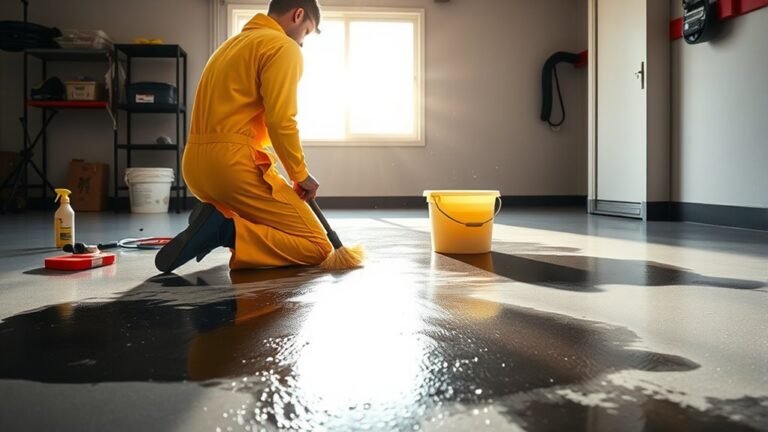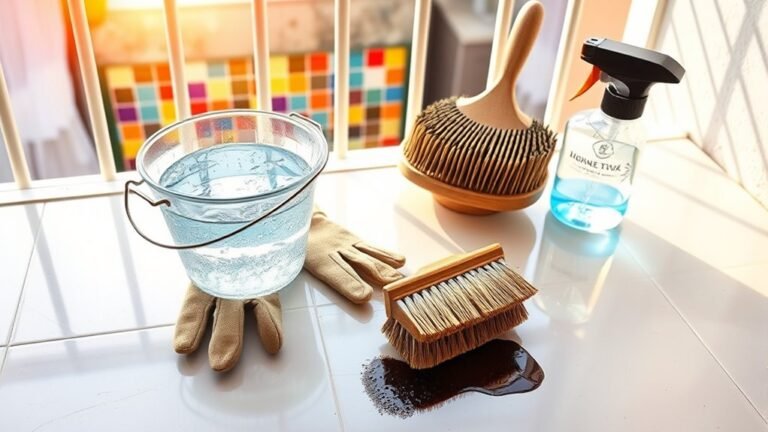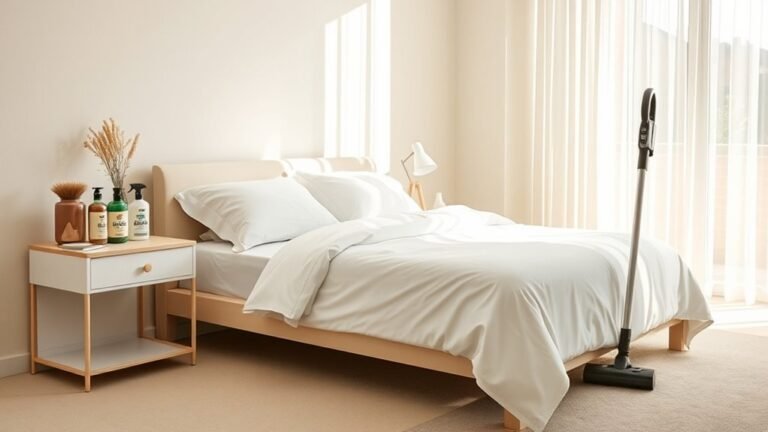Natural Cleaning Hacks for Your Baseboards
You can easily refresh your baseboards using natural ingredients like a vinegar and water spray for gentle cleaning and a baking soda paste to tackle tough stains. Lemon juice adds a natural antibacterial boost, while essential oils bring a fresh scent and shine. Regularly dust with a microfiber cloth to prevent buildup. These simple, eco-friendly tricks protect your floors from damage and keep your home healthy. There’s more to uncover about maintaining baseboards naturally and effectively.
Gather the Right Natural Cleaning Supplies

Before you plunge into cleaning your baseboards naturally, you’ll want to gather the right supplies to make the job easier and more effective. Choosing eco friendly options not only protects the environment but also gives you peace of mind. Start with basic items like microfiber cloths and soft brushes, which won’t scratch your surfaces. For homemade cleaners, simple ingredients like vinegar, baking soda, and lemon juice are powerful allies that you probably already have at home. Mixing these creates effective solutions to tackle grime without harsh chemicals. With these supplies in hand, you’re set to clean thoroughly while staying true to your values of freedom and sustainability. This approach guarantees your baseboards shine without compromising your commitment to an eco-conscious lifestyle.
Dusting Techniques for Baseboards
You’ll want to pick the best dusting tools like microfiber cloths or soft-bristle brushes to tackle your baseboards gently. Using effective dust removal methods, such as sweeping from top to bottom, helps prevent dirt from settling back. Let’s explore simple ways to keep your baseboards dust-free naturally.
Best Dusting Tools
Although dusting baseboards might seem straightforward, choosing the right tools can make the task much easier and more effective. You’ll want to grab microfiber cloths or dusting mitts—they trap dust without spreading it around. Electrostatic dusters and feather dusters are great for quick touch-ups, especially in hard-to-reach corners. Vacuum attachments designed for dusting can suck up debris without scratching your baseboards. For reusable options, cleaning pads and reusable wipes cut down waste and work wonders when dampened slightly. Don’t overlook lint rollers; they’re surprisingly handy for lifting fine dust and pet hair. Each tool gives you freedom to clean your baseboards efficiently, keeping them fresh and dust-free without hassle or harsh chemicals.
Effective Dust Removal Methods
Choosing the right dusting tools sets you up for success, but knowing how to use them effectively makes all the difference in keeping your baseboards spotless. To tackle dust accumulation while embracing eco friendly options, try these simple methods:
- Microfiber Cloth Technique – Lightly dampen an eco friendly microfiber cloth and gently wipe along the baseboards. This traps dust without scattering it.
- Vacuum with Brush Attachment – Use a vacuum’s brush tool for quick removal of loose dust, especially in hard-to-reach corners.
- Reusable Dusting Mitts – Slip on a washable dusting mitt made from natural fibers to capture dust while giving you freedom to move easily.
Using Vinegar and Water Solution

When tackling dirty baseboards, a vinegar and water solution offers a simple yet effective way to cut through grime without harsh chemicals. You’ll appreciate the vinegar benefits, like its natural antibacterial properties and ability to break down dirt effortlessly. To get the best results, stick to the right cleaning proportions—mix equal parts of white vinegar and warm water in a spray bottle. This balance guarantees your solution is strong enough to clean but gentle enough to protect your baseboards. Spray the mixture lightly, then wipe down with a soft cloth or sponge. This method not only frees you from using toxic cleaners but also gives you control over what touches your home, keeping your space fresh and safe.
Baking Soda for Stubborn Stains
If you’ve got stubborn stains on your baseboards, a baking soda paste can be a game-changer. Just mix baking soda with a little water, apply it, and gently scrub to lift grime without damaging the surface. With the right technique, you’ll see those tough spots start to fade away quickly.
Baking Soda Paste
Stubborn stains on baseboards can be tricky to remove, but a baking soda paste offers a simple, effective solution. You’ll love how this natural method taps into the baking soda benefits you’ve heard about. Here’s how to make and use your own baking soda paste:
- Mix 3 parts baking soda with 1 part water to create a thick paste—this classic baking soda recipe balances cleaning power and gentle abrasion.
- Apply the paste directly to the stained baseboard spots. Let it sit for 10-15 minutes, giving it time to lift grime without harsh chemicals.
- Wipe away with a damp cloth, revealing cleaner baseboards and enjoying the freedom of a natural, budget-friendly hack.
This paste respects your space and the environment while tackling tough stains effortlessly.
Gentle Scrubbing Techniques
A few simple scrubbing techniques can make all the difference when using baking soda on tough baseboard stains. To maintain your baseboards’ finish while removing stubborn marks, focus on gentle techniques that avoid damage. Use soft cloths or sponges to apply baking soda paste, then gently scrub in circular motions. Avoid harsh scrubbing methods that might scratch or wear down the paint.
| Scrubbing Method | Recommended Use |
|---|---|
| Soft cloth | Light stains, delicate surfaces |
| Soft-bristle brush | Stubborn dirt, textured baseboards |
| Sponge | Even application, general cleaning |
Stain Removal Tips
Two key ingredients in your cleaning arsenal for tough baseboard stains are baking soda and water. These natural cleaners tackle various stain types without harsh chemicals, giving you freedom from toxins. Here’s how to use them effectively:
- Mix baking soda with water to form a paste. This gentle abrasive targets stubborn marks without damaging paint or wood.
- Apply the paste to the stain, letting it sit for 5-10 minutes. This loosens dirt and grime that regular cleaning frequency might miss.
- Gently scrub with a soft cloth or brush, then wipe clean with a damp towel.
Lemon Juice as a Natural Cleaner
When you want a natural way to brighten and clean your baseboards, lemon juice is a fantastic option. Its lemon benefits go beyond just a fresh scent—it acts as a natural antibacterial agent, helping you tackle dirt and germs without harsh chemicals. Simply squeeze fresh lemon juice onto a cloth or mix it with water for a gentle, effective cleaner. You’ll notice grime lifting effortlessly, leaving your baseboards sparkling clean. Plus, lemon juice’s natural acidity breaks down buildup, making your cleaning routine quicker and easier. Using lemon juice means you’re choosing freedom from synthetic cleaners, embracing a simple, eco-friendly approach that’s safe for your home and family. It’s a smart, natural way to maintain your baseboards with minimal effort.
Essential Oils for Freshness and Shine

Essential oils bring a natural burst of freshness and shine to your baseboards, making your cleaning routine more enjoyable and effective. You can easily elevate your approach with essential oil blends that combine cleansing power and invigorating scents. Here’s how to do it:
- Mix a few drops of citrus freshness oils like lemon or orange with water in a spray bottle for a bright, clean finish.
- Add essential oil blends containing eucalyptus or tea tree to your cleaning solution to boost antimicrobial effects.
- After wiping, use a dry cloth with a drop of your favorite essential oil to polish the baseboards, leaving a subtle, uplifting aroma.
This simple addition lets you clean freely while keeping your home inviting and naturally fresh.
Preventing Dust Build-Up Naturally
Although dust tends to settle quickly on baseboards, you can take simple, natural steps to minimize its buildup. Start by improving air circulation in your home—open windows regularly and use fans to keep the air moving. This helps prevent dust from settling and keeps your space feeling fresh. You can also place indoor plants that naturally purify the air, reducing dust particles. Another effective dust prevention trick is to keep fabrics like curtains and upholstery clean, as they often trap dust that eventually settles on baseboards. By focusing on these natural strategies, you’ll cut down on dust buildup without relying on harsh chemicals, giving you more freedom to enjoy a clean, healthy home environment.
Tips for Regular Maintenance and Care
Since baseboards are often overlooked, keeping up with regular maintenance is key to preserving their appearance and preventing dirt buildup. You can enjoy that fresh, clean look without much hassle by committing to routine cleaning. Here are three simple tips for effective baseboard maintenance:
Regular maintenance keeps baseboards looking fresh and prevents dirt buildup with minimal effort.
- Schedule a quick wipe-down every two weeks using a damp microfiber cloth to catch dust and grime before it settles.
- Use a gentle mixture of vinegar and water for stubborn spots; it’s natural and won’t damage your paint or wood.
- Check for any chips or cracks during cleaning and touch them up promptly to avoid bigger repairs.
Stick to these tips, and your baseboards will stay looking crisp, giving you freedom from constant deep cleaning.
Frequently Asked Questions
Can Natural Cleaners Damage Painted Baseboards?
You might worry if natural cleaners can damage your painted baseboards, but when you use natural ingredients like vinegar, baking soda, or lemon juice carefully, you’re usually safe. These gentle options help maintain paint protection without harsh chemicals. Just avoid soaking the wood and test a small area first to keep your baseboards looking fresh. This way, you enjoy freedom from toxins while protecting your home’s finish effortlessly.
How Often Should I Deep Clean Baseboards Naturally?
You should aim for a deep cleaning frequency of about every three to six months to keep your baseboard maintenance on point. This schedule helps prevent dirt buildup without feeling like a chore, giving you the freedom to enjoy a fresh, clean space. Of course, if you have pets or kids, you might want to deep clean a bit more often. Stick to natural methods to protect your paint and keep things eco-friendly!
Are Natural Cleaning Methods Safe for Pets?
Ever worry about what invisible dangers might lurk in your cleaning products? When you choose pet safe ingredients like vinegar, baking soda, or lemon juice, you’re giving your furry friends freedom from harmful chemicals. Just remember natural cleaning precautions—always test a small area first and keep pets away while cleaning. This way, you protect your home and your pets, letting everyone enjoy a fresh, safe environment without compromise.
Can I Use Essential Oils on Wood Baseboards?
You can use essential oils on wood baseboards, but you’ll want to be careful. Essential oils benefits include natural antibacterial properties and pleasant scents, which can freshen your space while cleaning. However, some oils might damage the wood’s finish, so always dilute them with a carrier oil or water and test on a small spot first. This way, you protect your wood care routine and enjoy a cleaner, freer home environment.
What Natural Cleaner Removes Mold From Baseboards?
Imagine your baseboards as a loyal guardian, tarnished by unwelcome invaders like mold. To reclaim their honor, you can summon a vinegar solution—nature’s own warrior—sprayed directly onto the spores. Let it sit, then sprinkle baking soda, the silent ally, to scrub away resistance gently. Together, they form a natural alliance that liberates your baseboards, giving you the freedom to enjoy a clean, healthy home without harsh chemicals.






